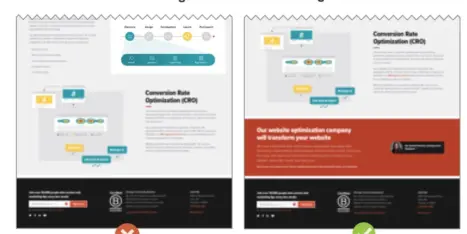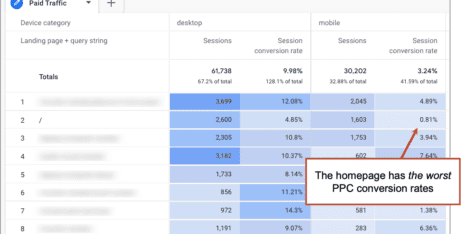I’ve asked the best and brightest analytics pros to answer a few questions that we all have when it comes to analytics; What metrics should we be focusing on? How does my website compare to the competition? What’s with all this “not provided” gibberish?
Let’s meet the experts and see what they have to say.
 |
Dr. Pete Meyers, Marketing Scientist at Moz, Mad Hatter of Mozcast, @dr_pete |
 |
Justin Cutroni, Analytics Evangelist at Google, @justincutroni |
 |
Neil Patel, Co-Founder of KISSmetrics, CrazyEgg, Founder of Quicksprout, @neilpatel |
 |
Annie Cushing, Founder of Annielytics, @AnnieCushing |
 |
Mike Pantoliano, Marketing Director at Ookla, @MikeCP |
 |
Nico Miceli, Google Developer Expert for Google Analytics, Analytics Associate at SEER Interactive, @NicoMiceli |
Question 1: What are some metrics that people should pay more attention to?
 |
Dr. Pete, Moz: |
Since I have some background on the usability side, I’m biased toward conversion metrics, but I honestly think that we can develop tunnel vision with any metric. Ultimately, you should measure what’s actionable for you.
If your conversion rate or lifetime value are amazing, but you have 3 visitors/month to your site, then those metrics aren’t helping you that much. If you have millions of unique visitors, but your conversion rate is 0.01%, then maybe you shouldn’t obsess quite so much about the traffic. I think it’s vital that we stop treating any metric as a one-size-fits-all solution.
 |
Justin Cutroni, Google: |
Assisted conversions and assisted revenue. Too many people are still using a last-click attribution model and discounting the cumulative nature of digital marketing. Everyone should understand how their campaigns assist other campaigns in generating conversions.
 |
Neil Patel, QuickSprout: |
People should pay attention to the metrics that are important to their business. The ones that affect their bottom line. For example, pageviews wouldn’t be a useful metric to track unless you are a publishing based business that makes money off of ads. If you were an ecommerce site you may look at average order value, or where people are dropping off within your checkout flow. As a SaaS company you may track lifetime value and churn. The metrics will vary per business type.
 |
Annie Cushing, Annielytics: |
Marketers should pay much more attention to data from different attribution models. Focusing on data from one from attribution model alone overlooks critical conversion data.
 |
Mike Pantoliano, Ookla: |
It certainly depends on your business model and growth stage, but engagement metrics like bounce rate (measured properly) are pretty much universally important. Frequency and recency are also great, but a bit lacking in actionability – definitely something people should be tracking and working to improve, though. In Google Analytics, I was always a fan of the Page Value metric for those that run eCommerce sites or have monetary goals set up.
 |
Nico Miceli, SEER Interactive: |
These are not necessarily metrics but I think it’s important to create segments and custom variables/dimensions (or custom groups for non-Google Analytics users) more to really learn about your different types of customers. Then you can throw any metrics you already use in there and see how it differs in each group.
Question 2: What are some metrics that everyone thinks are important, but are actually useless?
 |
Dr. Pete, Moz: |
Everything has its place, to a point, but I think we put way too much focus on basic social metrics, like followers/fans. The use cases for social really vary, and raw numbers frequently don’t tell us much. Sure, we all want the numbers to go up, but the vast majority of the real value (in actual dollars) I’ve gotten from Twitter, for example, has come from one-on-one interactions. Whether I have 20 followers or 20,000 might not matter if they’re the right followers at the right time and I can leverage those relationships.
I don’t want to suggest that raw numbers are irrelevant – obviously, the larger the network you have access to, the more opportunity you theoretically have. The problem comes when we treat the size of the network as an end instead of a means. There are plenty of tricks to amassing followers that kill quality for quantity.
 |
Justin Cutroni, Google: |
Average time on page. This metric can be very misleading, based on your analytics implementation. People should look at things like page depth. Or, even better, tweak your implementation and measure how many people actually read your content.
 |
Neil Patel, QuickSprout: |
Pageviews, bounce rate and time on site tend to be metrics that a lot of people look at, but aren’t too relevant. Whether you bounce rate goes up or down, it doesn’t mean your revenue will go up or down.
 |
Annie Cushing, Annielytics: |
I probably wouldn’t go so far as useless, but I do think that bounce rate is unduly prejudicial. Along with it, I’d include time on page and time on site. This is because all of these metrics depend on a visitor clicking through to another tracked page to record the time on a page. So a visitor can spend 20 minutes reading your blog post but then register as a big, fat zero because s/he didn’t click through to another page.
 |
Mike Pantoliano, Ookla: |
I wouldn’t say there’s any one metric that is universally useless, but there are plenty that are completely useless to track for certain types of businesses. For instance, Time on Site is kind of a funny metric to care about for eCommerce sites, but it means a ton to ad-supported content sites.
The most useless metrics are ones that are incorrectly configured or not relevant with the dimensions with which they’re being compared. If you’ve got a custom report setup that lists conversion rate (a session-scoped metric) by page (a hit-scoped metric), you’re doing it wrong. Always ensure you’re matching the scope of your metrics and dimensions, otherwise you’re really looking at useless data.
 |
Nico Miceli, SEER Interactive: |
With how the web has been changing I think there is more and more important things happening between pageviews. So I think the pageview idea needs to be updated or refreshed, for example if I said you got 10,000 pageviews but only 10 of them scrolled down to actually see your CTA, is the 10K still impressive?
Question 3: What’s your recommended strategy for understanding search traffic and analyzing “not provided” data?
 |
Dr. Pete, Moz: |
It’s not easy, and being at a search analytics company, we’ve talked about this a lot. Ultimately, I think we’re going to have to move toward a content-centric view, focusing on pages and the concepts they represent more than individual keywords.
It’s not just an issue of “not provided” – Hummingbird signaled Google’s strong intent to look at queries more flexibly and get away from treating any given search string as a rigid and literal entity with a fixed result. We have to expect searches to get interpreted more often and we need to get away from being fixated on specific strings and think more in terms of concepts.
 |
Justin Cutroni, Google: |
Look at organic traffic to landing pages and landing page categories. You can use this custom report to view landing pages for Google Organic traffic. It’s important to add the context of your SEO activities.
 |
Neil Patel, QuickSprout: |
This post will teach you how to analyze and look at not provided data:
 |
Annie Cushing, Annielytics: |
Focus on the performance of landing pages. There’s enough gold in those hills to more than make up for the lack of keyword data.
 |
Mike Pantoliano, Ookla: |
It’s only a matter of time before we have zero organic keywords from Google, so I think it’s best to focus on the landing page dimension, rather than keywords. Data from Google Webmaster Tools is pretty imprecise, so don’t go slicing and dicing it down too far. It can be used for trend analysis, though.
I’m still waiting for Google Analytics to start pre-aggregating the organic landing pages report. For large sites, the organic keywords report is pre-aggregated, but includes 95% ‘not provided’. Switching over to landing page as the primary dimension is sampled, unfortunately, which makes focusing on landing pages a bit more difficult. I solve this by creating an organic-only view in GA, but it should be default behavior by now.
 |
Nico Miceli, SEER Interactive: |
I like to look at keywords that you know are ranking or keyword themes for a page and then report on organic search traffic to that landing page. It’s not as exact as it used to be but you can see your campaign is doing well around a keyword that has moved up and you’re getting more traffic to that page. If it’s doing worse it’s probably because your keywords have dropped.
Question 4: How do you answer the question “how does my site compare to other sites in my industry?” (a.k.a benchmarking)
 |
Dr. Pete, Moz: |
Maybe this is a luxury of the kind of work that I do, but I try not to worry about that question too much. You can’t ignore your competitors, especially when it comes to overall strategy, but I’m honestly not sure how much value benchmarking has the way we usually use (and abuse) it. If I’m making my revenue/profit/etc. goals (assuming we’re talking about an e-commerce site), I’m growing, etc., then how much does it matter if a competitor is 27% bigger or has a conversion rate that’s 0.6% lower or 987 more Facebook fans?
Benchmarking can tell us about the overall opportunity in an industry, and it can tell us about general trends (are all the boats sinking, or is it just mine?), but too often benchmarking becomes an exercise in vanity. Add to that that numbers about the competition are quite often best guesses, and I think you have to really make sure there’s a purpose to any questions you ask about the competition.
 |
Justin Cutroni, Google: |
Good question. Before you benchmark against any other site make sure you’re looking at YoY growth for your own business and benchmarking against internal targets. For external data, I like to use sites like Compete.com to understand what my competitors are doing. Another free service is the FireClick. And if you’re into ecommerce there’s also some great data from Custora.
 |
Neil Patel, QuickSprout: |
It doesn’t matter how you compare to other sites in your space, you should just try to continually improve. By all means you should learn from competitors, but what works for them may not work for you.
 |
Annie Cushing, Annielytics: |
I rely on competitive data, such as Compete and SEMRush.
 |
Mike Pantoliano, Ookla: |
I don’t really have a good answer for this one. I’ve been lucky enough to have had access to the analytics for thousands of websites in my life, so at some point you start to get a feel for what the bounce rate should be for an IT services lead-gen site, or the cart abandonment rate for a high-ticket eCommerce site.
My advice to anyone seeking to weigh themselves against competition would be to prod around on the internet a bit, and maybe pose a question in a relevant forum — or do the real-life equivalent of this by going to and asking people at industry events. But at some point it’s best to just move on and do good work and not worry about where you stand against competition.
 |
Nico Miceli, SEER Interactive: |
The first thing to do is to make sure they have clean analytics, which unfortunately isn’t always the case. A lot of times companies have their analytics set up with the set it and forget it mind set which is totally wrong. All updates that are performed on the site should have analytics in mind to make sure it doesn’t break anything or there is not something cool that you should be tracking.
I’ve seen goals pulling from the wrong URLs, self-referral traffic, and event tracking that’s broken. Once that’s cleaned up we can dive in and see how the site is performing. In regards to how the site compare’s to other sites in the industry for analytics, that’s where it gets fun digging around in the source code of competitors and seeing what they are tracking (as long as they aren’t using any server side analytics).
Question 5: What is the future of Analytics?
 |
Dr. Pete, Moz: |
As marketers become more sophisticated, I think we’re going to see a lot more segmentation, especially across devices. It used to be that we just had to worry about screen size and browsers. Now, add in phones and tablets and, in the next couple of years, wearable technology (like Google Glass) with full browsing capability but limited screen space.
We’re also seeing more and more channels and a stronger focus on cross-channel measurement and attribution. If I discover your brand via my phone on the bus, and then my friend mentions you on Facebook, and then I do a search to get more details, and finally I forget I was interested, land on a retargeting ad, and purchase, where does the credit go? What channel is really working? These are tough questions that are going to take sophisticated tools and smart analysts.
 |
Justin Cutroni, Google: |
User centric measurement and a focus on retention marketing. This is really two different things.
First, with all the different screens that consumers use today, we need to switch our measurement from device specific to user specific. This will give us a better picture of user behavior. Obviously this is hard as we need a primary key to understand users. But we’re moving in the right direction with things like Universal Analytics and the User-ID. Once we have that, it will be easier for us to understand customer churn and what we need to do to retain our customers.
 |
Neil Patel, QuickSprout: |
I think analytical platforms will become more actionable and be less report oriented. Ideally we shouldn’t have to view any reports, the tool should just tell you what changes to make.
 |
Annie Cushing, Annielytics: |
Visitor-based analytics, as opposed to sessions-based solutions. It’s the only way marketers will ever resolve data across devices.
 |
Mike Pantoliano, Ookla: |
More and more focus on the individual user – not their browser’s cookies or their device’s unique ID. That means getting people to create a login and tie that user’s sessions together across all of their devices.
Google Analytics is rolling out support for User ID overwrite, which is huge. Everyone should work on getting this set up. Many other analytics platforms already have this functionality. With the prevalence of 2nd and 3rd screens, we’re going to be working to make sense of a single user’s behavior quite a bit over the next few years.
 |
Nico Miceli, SEER Interactive: |
This is where I spend a lot of time, and I think the short answer is (1) tracking more things and (2) tying back to individual users to see what leads to sales. This leads to a customer centric approach that will give you a better idea of the customers that matter.
The web has evolved a lot since the first page and with that there are more and more things that we should track that are happening between page views. Long scroll sites, videos, tabbed content and lots of sweet HTML5 stuff now need to be tracked with custom events and virtual pageviews. We are already seeing some more of this with the rise of Tag Management solutions.
The ability to send data to Analytics platforms like Google Analytics from other devices such as store kiosks and Point of sale systems and tie it to a single site user is huge since the online and offline thing has always got attention. I’ve been really getting into the BF Skinner school of thought that our behavior is based on the outcomes of our previous actions and conditioning, so my mindset is lets track and test every part of the buying process and find that connection/color/cta that converts best.
Question 6: If you were trapped on a deserted island what one metric would you take with you?
 |
Dr. Pete, Moz: |
CPA – Coconuts Per Acre? If I really had to pick just one, I’m a practical guy, and I’d focus on the bottom line – revenue. Visitors X Conversion Rate X Average Revenue per Sale = Revenue. Ultimately, that one number tells me if I’m passing or failing, even if it doesn’t tell me why. Sometimes, we forget that all of the other metrics were created to dig deeper and tell the whole story.
 |
Justin Cutroni, Google: |
Profit & Satisfaction! Sorry, I had to take two – one quantitative and one qualitative 😉
 |
Neil Patel, QuickSprout: |
None… I would try and find water/food. Metrics wouldn’t be important.
 |
Annie Cushing, Annielytics: |
Revenue, if available. Total conversions if not. I’m all about the bottom line. #pragmatist 🙂
 |
Mike Pantoliano, Ookla: |
Bounce Rate. Because I heard he’s really good at catching fish, opening coconuts, and starting a fire :).
 |
Nico Miceli, SEER Interactive: |
Goal conversions! End of the day, I need to know how much money the site is making right?
Special thanks to all of our analytics experts that contributed!
If you have your own questions, feel free to pop them into the comments below.




